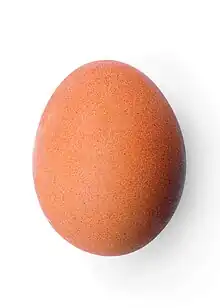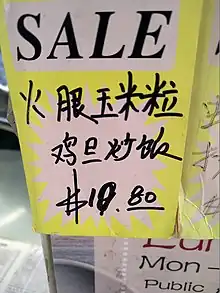蛋
| ||||||||
Translingual
| Stroke order | |||
|---|---|---|---|
 | |||
Han character
蛋 (Kangxi radical 142, 虫+5, 11 strokes, cangjie input 弓人中一戈 (NOLMI), four-corner 17136, composition ⿱疋虫)
References
- Kangxi Dictionary: page 1081, character 11
- Dai Kanwa Jiten: character 32977
- Dae Jaweon: page 1549, character 5
- Hanyu Da Zidian (first edition): volume 4, page 2845, character 18
- Unihan data for U+86CB
Chinese
Glyph origin
Characters in the same phonetic series (延) (Zhengzhang, 2003)
Phono-semantic compound (形聲/形声, OC *l'aːns) : phonetic 延 (OC *lan, *lans) + semantic 虫 (“snake, insect”). 延 is abbreviated to 疋.
Etymology 1
| simp. and trad. |
蛋 | |
|---|---|---|
| 2nd round simp. | 旦 | |
| alternative forms | 疍 蜑 鴠/𱉗 旦 informal (especially Cantonese) | |

蛋
From 彈 (MC danH, “pellet”) (Zhengzhang, 2003).
Pronunciation
Definitions
蛋
Usage notes

A sign reading 鸡旦炒饭 ("[chicken] egg fried rice"), which uses 旦 instead of 蛋
Occasionally spelled with the character 旦 instead, especially in the menus of cha chaan tengs, as it is faster to write when taking orders).
Synonyms
Dialectal synonyms of 蛋 (“egg (of a bird or reptile)”) [map]
Dialectal synonyms of 睪丸 (“testicle”) [map]
Dialectal synonyms of 零蛋 (“goose egg; score of zero”) [map]
Compounds
- 下蛋 (xiàdàn)
- 下蛋雞/下蛋鸡
- 丫蛋
- 乾蛋/干蛋
- 二蛋
- 亡八蛋
- 倒楣蛋
- 倒蛋
- 倒霉蛋 (dǎoméidàn)
- 傻瓜蛋
- 傻蛋 (shǎdàn)
- 光蛋 (guāngdàn)
- 冰蛋
- 刁蛋
- 吃鴨蛋/吃鸭蛋
- 喜蛋 (xǐdàn)
- 地蛋
- 圪蛋
- 壞蛋/坏蛋 (huàidàn)
- 完蛋 (wándàn)
- 寡蛋
- 寶貝蛋/宝贝蛋
- 屎蛋 (shǐdàn)
- 山藥蛋/山药蛋 (shānyaodàn)
- 巨蛋 (jùdàn)
- 忘八蛋
- 扯蛋 (chědàn)
- 扭蛋 (niǔdàn)
- 抱蛋
- 掛球蛋/挂球蛋
- 掉蛋
- 搗蛋/捣蛋 (dǎodàn)
- 搗蛋鬼/捣蛋鬼 (dǎodànguǐ)
- 攤蛋/摊蛋
- 文蛋
- 昏蛋
- 暖蛋
- 松花彩蛋
- 松花蛋 (sōnghuādàn)
- 核蛋白 (hédànbái)
- 毛蛋 (máodàn)
- 毛蛋蛋子
- 毬毬蛋蛋/球球蛋蛋
- 泥蛋
- 海綿蛋糕/海绵蛋糕 (hǎimián dàngāo)
- 混蛋
- 渾蛋/浑蛋
- 滾蛋/滚蛋 (gǔndàn)
- 滷蛋/卤蛋 (lǔdàn)
- 炒蛋 (chǎodàn)
- 烏魚蛋/乌鱼蛋
- 烏鴉閃蛋/乌鸦闪蛋
- 爬蛋
- 王八蛋
- 球蛋白 (qiúdànbái)
- 生蛋 (shēngdàn)
- 番茄炒蛋 (fānqié chǎodàn)
- 畫蛋/画蛋
- 白煮蛋
- 白蛋白 (báidànbái)
- 皮蛋 (pídàn)
- 瞎扯蛋
- 瞎炒蛋
- 砸蛋
- 碰蛋
- 窮光蛋/穷光蛋 (qióngguāngdàn)
- 窮蛋/穷蛋
- 笨蛋 (bèndàn)
- 節蛋/节蛋
- 糊塗蛋/糊涂蛋
- 糟蛋 (zāodàn)
- 紅蛋/红蛋 (hóngdàn)
- 纖維蛋白/纤维蛋白
- 老實圪蛋/老实圪蛋
- 肏蛋 (càodàn)
- 胡塗蛋/胡涂蛋
- 胃蛋白酶 (wèidànbáiméi)
- 胰蛋白酶 (yídànbáiméi)
- 膠元蛋白/胶元蛋白
- 臉蛋/脸蛋 (liǎndàn)
- 臥蛋/卧蛋
- 茶葉蛋/茶叶蛋 (cháyèdàn)
- 草雞蛋/草鸡蛋
- 荷包蛋 (hébāodàn)
- 蛋丁
- 蛋丘
- 蛋中挑刺
- 蛋人
- 蛋划
- 蛋卷 (dànjuǎn)
- 蛋品
- 蛋圓/蛋圆
- 蛋塔 (dàntǎ)
- 蛋子
- 蛋家 (dànjiā)
- 蛋家公
- 蛋市
- 蛋彩畫/蛋彩画
- 蛋戶/蛋户
- 蛋户
- 蛋撻/蛋挞
- 蛋散 (dànsǎn)
- 蛋殼/蛋壳 (dànké)
- 蛋民 (dànmín)
- 蛋清 (dànqīng)
- 蛋白 (dànbái)
- 蛋白尿 (dànbáiniào)
- 蛋白質/蛋白质 (dànbáizhì)
- 蛋粉
- 蛋糕 (dàngāo)
- 蛋花 (dànhuā)
- 蛋花湯/蛋花汤 (dànhuātāng)
- 蛋雞/蛋鸡 (dànjī)
- 蛋青
- 蛋青色
- 蛋頭/蛋头
- 蛋餅/蛋饼 (dànbǐng)
- 蛋黃/蛋黄 (dànhuáng)
- 蛋黃精/蛋黄精
- 蛋黃醬/蛋黄酱 (dànhuángjiàng)
- 蜘蛛抱蛋
- 血漿蛋白/血浆蛋白 (xuèjiāngdànbái)
- 血紅蛋白/血红蛋白 (xuèhóng dànbái)
- 調皮搗蛋/调皮捣蛋
- 變蛋/变蛋 (biàndàn)
- 起司蛋糕 (qǐsī dàngāo)
- 趴蛋
- 軟殼雞蛋/软壳鸡蛋
- 軟蛋/软蛋 (ruǎndàn)
- 軟雞蛋/软鸡蛋
- 轉蛋/转蛋
- 酪蛋白 (làodànbái)
- 雞蛋/鸡蛋 (jīdàn)
- 雞蛋清/鸡蛋清
- 雞蛋青/鸡蛋青
- 雞蛋餅/鸡蛋饼
- 雞飛蛋打/鸡飞蛋打 (jīfēidàndǎ)
- 零蛋 (língdàn)
- 飛機下蛋/飞机下蛋
- 飛蛋/飞蛋
- 馬蛋/马蛋
- 鬆蛋包/松蛋包
- 鬼扯蛋
- 鳳凰蛋/凤凰蛋
- 鴨蛋/鸭蛋 (yādàn)
- 鴨蛋圓/鸭蛋圆
- 鴨蛋粉/鸭蛋粉
- 鴨蛋臉/鸭蛋脸
- 鴨蛋臉兒/鸭蛋脸儿
- 鴨蛋青/鸭蛋青
- 鴕鳥蛋/鸵鸟蛋
- 鵝蛋石/鹅蛋石
- 鵝蛋臉/鹅蛋脸
- 鵝蛋臉兒/鹅蛋脸儿
- 鹹蛋/咸蛋 (xiándàn)
- 鹹風蛋雨/咸风蛋雨
- 鹹鴨蛋/咸鸭蛋 (xiányādàn)
- 鹽蛋/盐蛋
- 麻蛋
- 龍郎蛋女/龙郎蛋女
Etymology 2
| simp. and trad. |
蛋 | |
|---|---|---|
| alternative forms | 單/单 端 | |
(This etymology is missing or incomplete. Please add to it, or discuss it at the Etymology scriptorium.)
Pronunciation
Japanese
Compounds
Compounds
- 蛋白 (tanpaku): protein; egg white
- 蛋白質 (tanpakushitsu): protein
- 蛋白尿 (tanpakunyō): albuminuria
- 蛋白分解酵素 (tanpaku bunkai kōso): protease, an enzyme that breaks down protein
- 蛋白消化酵素 (tanpaku shōka kōso): protease, an enzyme that breaks down protein
- 蛋白石 (tanpakuseki): opal
- 蛋民 (tanmin): the Tanka ethnic group of southern China
Korean
Hanja
蛋 • (dan) (hangeul 단)
- This term needs a translation to English. Please help out and add a translation, then remove the text
{{rfdef}}.
Vietnamese
Han character
蛋: Hán Nôm readings: đản
- This term needs a translation to English. Please help out and add a translation, then remove the text
{{rfdef}}.
This article is issued from Wiktionary. The text is licensed under Creative Commons - Attribution - Sharealike. Additional terms may apply for the media files.